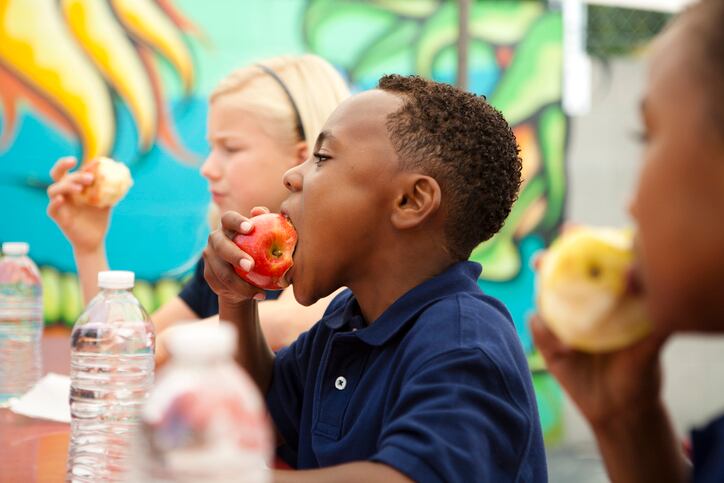At the Academy of Nutrition and Dietetics Food & Nutrition Conference and Expo (FNCE) in Orlando this week, USDA director of nutrition and security Sara Bleich explained the agency hopes that its recently announced Healthy Meal Incentives program, which earmarks $100 million to encourage schools “to go above and beyond” the formal nutrition standards, also will “push industry to reformulate in ways that are going to provide healthier items to children, hopefully not just in schools, but … on grocery store shelves.”
She explained that the Healthy Meal Incentive program, which USDA announce in June as part of a larger framework for “shoring up the food supply chain and transforming the food system to be fairer, more competitive [and] more resilient,” will support peer-to-peer learning and recognize local programs for their efforts to deliver nutritious food – something that she acknowledged is difficult under the current reimbursement and participation scheme.
“[Being] a food service director [at a school] … is a hard job when you’ve got limited resources,” Bleich told a foodservice director at a district in Pennsylvania who complained at FNCE that reimbursement and student participation rates at many schools are so low that schools are forced to purchase the least expensive ingredients and ready-made products, which often are not as healthy as those made from scratch, “for example powdered donuts for breakfast instead of breakfast burritos.”
Bleich encouraged the foodservice director to “lean on your colleagues for advice on how to do more and do better with limited resources,” which will also be easier with the funding made available through the Healthy Meal Incentive program.
As schools share learnings and improve their offerings they should be able to attract more students to participate in their meals programs, which will in turn increase their buying power. Working together also will increase schools’ influence over food manufacturers – so that as they demand healthier options, it should, in theory, push manufacturers to innovate or renovate offerings that are sold in schools and at retail.
Bleich’s optimism rests in part on the belief that manufacturers, many of which have aggressively streamlined their operations and portfolios since the beginning of the pandemic, will not want to make multiple versions of products for different settings – such as at school for federal reimbursement and at retail for home consumption.
A return of universal free school meals could sway manufacturers to reformulate
Schools also can boost student participation – and by extension their budgets – by offering universal free meals, which had been an option for all schools during the pandemic, but the waivers for which were not renewed by Congress for this academic year.
“What that means, obviously, is that families now have to go back to applying for free and reduced lunch if they don’t live in an area that have a program like the community eligibility provision, which lets you serve all kids without having to fill out an application,” Bleich said.
She added since this change took place “we are finding … it is confusing for families” and many don’t know that they need to apply, how to apply or that is never too late in the school year to apply.
On this front, she asked FNCE attendees to use a toolkit provided by USDA to encourage and help more families to apply for financial help with school meals .
“What we find is that we can do a lot of messaging in the federal government, but we often have a last mile problem. How do you actually get to folks on the ground? You all are the trusted voices so we appreciate your partnership and trying to make sure that we get this most important message to families,” she said.
‘Our number one priority is universal meals for our children’
Bleich added that at the same time that USDA is trying to enroll families for financial support for school meals, the agency also is trying to bring back universal free school meals under the White House’s recently published National Strategy on Hunger, Nutrition and Health.
“Under the national strategy there are over 60 actions that are directly in USDA’s lane or for which we have cross equity [with other departments],” but “our number one priority is universal meals for our children,” she said.
She explained that through the national strategy “there’s a pathway for how we’re going to get there,” but it will take cooperation from Congress to make it happen.
While this cooperation may be a longshot, Bleich reiterated, “it is a number one priority for USDA. It is a priority for the White House – we just have to keep momentum going and just keep pushing hard on this issue.”
She stressed that universal free school meals don’t “just [help] children who are historically underserved or lower income. We’re helping all children,” and “we’re promoting innovation” in the marketplace as manufacturers that want to secure such large accounts will need to step up and offer healthier products.
She also told attendees that USDA plans to reinforce this outcome with “announcements coming out about school meal standards” in the coming months as well as efforts to modernize other nutrition benefits to make it easier for Americans to access healthier options – even if they are more expensive.
This includes a substantial increase in SNAP benefits this fall to meet inflation and efforts to modernize purchases through the Women, Infant and Children program.



